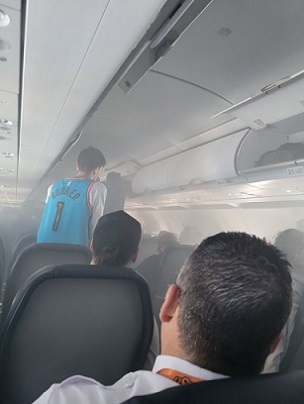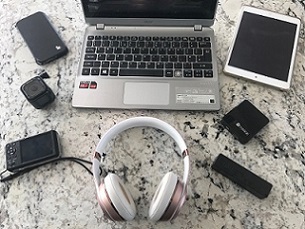 A lithium battery fire filling an aircraft passenger cabin with toxic smoke
A lithium battery fire filling an aircraft passenger cabin with toxic smoke
 A pilot with an AvSax lithium battery thermal fire mitigation bag
A pilot with an AvSax lithium battery thermal fire mitigation bag
 All these personal electronic devices are powered by lithium batteries
All these personal electronic devices are powered by lithium batteries
A lithium battery fire on a passenger plane arriving from Hawaii is the latest in a worrying spate of fires in aircraft following a shock report there has been a massive increase.
An iPad is thought to have become crushed in a seat on the Hawaiian Airlines plane from Honolulu descending into Portland, Oregon, on Thursday, September 19, 2024.
The cabin crew tackled the fire and put the device into a lithium battery fire mitigation bag with the plane continuing for a safe landing in Portland where it was met by the airport’s firefighters.
The Federal Aviation Administration in the USA reported: “Hawaiian Airlines Flight 26 landed safely at Portland International Airport around 8.45pm local time on Thursday, September 19, after the crew reported an iPad caught fire. The FAA will investigate.”
The incident follows a recent shock report by UL Standards & Engagement (ULSE) in the USA showing a 28% increase in battery thermal runaway incidents – a record high – on aircraft yet limited passenger awareness of the dangers of lithium-ion batteries while flying.
Many passengers don’t even know their personal electronic devices are powered by lithium batteries and are ignorant of the rule that all devices must always be taken into the passenger cabin with them and never put in checked luggage in the aircraft hold.
ULSE is a nonprofit organisation that translates safety science into action through setting standards and since 1903 has developed nearly 1,700 standards and guidance documents for products ranging from fire doors to autonomous vehicles. You can read more on its lithium battery report at https://avsax.com/news/shock-report-reveals-massive-rise-in-the-number-of-lithium-battery-fires-on-board-planes
Just a few days ago the FAA reported there have been 10 lithium battery fires on aircraft in just a month, thought to be the highest ever tally in such a short space of time.
The FAA has recorded the 10 incidents between July 15, 2024 and August 14, 2024 – including two on the same day - and released details to the public.
But they also warn this may not be all the incidents, stressing: “These are lithium battery related events involving smoke, fire or extreme heat that the FAA is aware of and should not be considered a complete listing of all such incidents.”
When lithium batteries overheat or are damaged they go into thermal runaway and when this happens one cell in a battery overheats it can produce enough heat – up to 900°C (1652°F) – to cause adjacent cells to overheat.
The heat generated by chemical reactions inside the battery causes even more heat, leading to a continuous rise in temperature. This can result in the battery venting and releasing toxic flammable gases, exploding or catching fire and because they burn at such a high temperature they are very difficult to put out.
This is why many airline companies are now equipped with AvSax lithium battery thermal fire mitigation bags and there are now on board almost 17,000 aircraft globally and have been deployed in action dozens of times. When they are deployed the aircraft is safe and can continue to its scheduled destination without having to make a diversion or emergency landing which is both costly and highly disruptive for passengers.
AvSax were devised in the UK by Environmental Defence Systems Ltd based in Huddersfield, Yorkshire, England, and are the most widely deployed thermal fire containment bags in the airline industry.
For more on AvSax go to https://avsax.com/